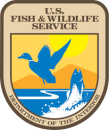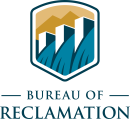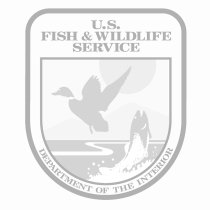Location
States
New MexicoEcosystem
River/stream, WetlandIntroduction
The Rio Grande Silvery Minnow (Hybognathus amarus) is a small cyprinid (minnow) that once inhabited a 3,000 mile stretch of the Rio Grande River in New Mexico and Texas (Espanola, New Mexico, through Texas to the Gulf of Mexico). Its life cycle depends on seasonal flooding because it spawns in slow flowing water in the floodplain instead of in the main channel where flows are swift. Due to dam construction and channel straightening that moderate floods, Silvery Minnow ranges have decreased from 3,000 river miles to 200 river miles, from Cochiti Pueblo to Elephant Butte Reservoir in New Mexico. Federally listed as an Endangered species in 1994, Silvery Minnow populations have continued to decline. However, flows in this reach of the Rio Grande still fluctuate sufficiently to mimic natural variability. Native riparian riparian
Definition of riparian habitat or riparian areas.
Learn more about riparian and aquatic species can be supported with supplemental management to enhance floodplain features.
To address the many conservation challenges facing the Silvery Minnow, the Bureau of Reclamation, U.S. Fish and Wildlife Service, and the Save Our Bosque Task Force worked closely with a local landowner, Doris Rhodes, to restore approximately 0.8 river miles of critical habitat. Modifications to the riverbank and riparian area included reduced flow velocity through bank lowering and constructing a backwater side channel that is connected to the main channel by a series of short, shallow passages called embayments. These modifications improved seasonal flooding capacity by providing additional backwaters and seasonally inundated floodplains for the river to flow during high snowmelt periods and runoff from monsoonal storms, which will accommodate Silvery Minnow spawning in the future.
Key Issues Addressed
The range of the Rio Grande Silvery Minnow has decreased from a 3,000 mile stretch of river to 200 miles as the population struggles to find suitable habitat. Ecological challenges facing Silvery Minnow restoration include increased velocity of stream flow and decreased frequency of silty, inundated floodplains that the Silvery Minnows require in order to spawn. Installation of dams that moderate overbank flooding, channelization that increases velocity of flows, and water withdrawals of water via pumping and diversion decrease water from the river together decrease habitat availability and/or degrade habitat quality for the Silvery Minnow.
The historic Rio Grande floodplain is comprised primarily of agricultural fields. The river provides a majority of the water for crop production as well as water for municipal use. Dams, levees, and channelization limit river flows to prevent the flooding of cities, towns, and fields which has inadvertently limited habitat for many aquatic species.
Despite these challenges, restoration that includes mechanical bank lowering as well as creation of side channels and embayments provides a realistic option for increasing Silvery Minnow habitat without decreasing water available for farms and cities.
Project Goals
- Work with a private landowner to create functional fish habitat while minimizing construction impacts and maintaining visual appeal and recreational value
- Increase floodplain connectivity to provide suitable fish habitat throughout the year
Project Highlights
A Community Inspired: Habitat restoration for the Rio Grande Silvery Minnow at the Rhodes property encourages other landowners to pursue environmental stewardship opportunities for their properties.
- Restoration with Private Landowners: The Rhodes property is a 536 acre river-front plot that has been owned by the Rhodes family for decades. Historically used for grazing, it was recently placed into a conservation easement conservation easement
A conservation easement is a voluntary legal agreement between a landowner and a government agency or qualified conservation organization that restricts the type and amount of development that may take place on a property in the future. Conservation easements aim to protect habitat for birds, fish and other wildlife by limiting residential, industrial or commercial development. Contracts may prohibit alteration of the natural topography, conversion of native grassland to cropland, drainage of wetland and establishment of game farms. Easement land remains in private ownership.
Learn more about conservation easement with the Natural Resources Conservation Service. The Rhodes property is one of the few remaining wetlands on the Middle Rio Grande that is not confined by a levee and serves as a refuge for native resident and migratory species. It is home to several federally listed species including the southwestern willow-flycatcher, yellow-billed cuckoo, Pecos sunflower, and Rio Grande Silvery Minnow. - Long-Time Partnerships: The owner of the Rhodes property, Doris Rhodes, has been working with federal and state agencies, non-profit organizations, and consultants to improve the ecological functions of her property for many years. Partners have included the Bureau of Reclamation, Natural Resources Conservation Service, Save Our Bosque Taskforce, Socorro Soil and Water Conservation District, GeoSystems Analysis Inc., and New Mexico Department of Game and Fish.
- Site Assessment to Guide Restoration: A baseline assessment was conducted to map soil types, vegetation species cover, and hydrology. This work guided non-native plant treatments, native species planting, and alteration of floodplain topography.
- Inundated Edge Habitat: Edge habitat for Silvery Minnows was created by including multiple embayments that lead from the new side channel to the main channel. This provides Silvery Minnows with multiple escape routes if their channel starts to dry.
- Native Vegetation Salvage: With the use of heavy machinery, plants can often be overlooked. On the Rhodes property native plants were extracted with roots intact and replanted at the project site.
- Minimizing Construction Disturbance: Construction of the project required the use of heavy machinery in and adjacent to the Rio Grande. Care was taken to minimize tractor impacts by reducing vehicle speeds and checking for fluid leaks. Refueling occurred away from the floodplain. Work was put on hold if water turbidity surpassed an established threshold and use of water pulled from the river was minimized so as not to disrupt downstream water rights.
Lessons Learned
The Rhodes property was an ideal location for Silvery Minnow habitat because it is one of the few remaining areas on the Middle Rio Grande where the groundwater is high enough to promote surface flows in the floodplain. This promotes water flowing into the floodplain during seasons of high flow, and supports native riparian vegetation that requires shallow groundwater. Working on a riverbank can be challenging due to the fluctuations of daily and seasonal river flow. The slope, substrate, and water velocity at the project site were liable to change fast and frequently, so the Socorro Field Division had to maintain a flexible construction schedule.
A baseline site assessment was completed to map vegetation, soil types, and hydrological characteristics across the 536 acre property to determine areas with the highest inundation potential. The area closest to the river was chosen for restoration of Silvery Minnow habitat. While it was initially a large financial investment, a baseline site assessment ensured the ideal location of the riverbank restoration project and can also be used in future restoration projects including non-native vegetation management and riverbank restoration.
The Rhodes property, after over fifteen years of restoration work, showcases the many benefits of private lands conservation. Locals become engaged as they watch wildlife recolonize newly available habitat and become potential partners for restoration on their own land.
Next Steps
- Monitor Flows: Silvery Minnows prefer slow flowing water and will not spawn successfully if the water is moving too fast. The longevity of the side channel and accompanying embayments may also be compromised if stream flow is consistently higher than expected.
- Minimize Vegetation Encroachment: Silvery Minnows require silty substrate without vegetation, so the side channel and embayments will be monitored for encroachment on the project site. The property as a whole will continue being assessed for non-native plants and treated with herbicides on a regular basis. Russian knapweed, pepperweed, tumbleweed, and kochia patches represent areas of high priority for herbicide application on a yearly schedule. Russian olive and saltcedar respond to both mechanical and herbicide treatment depending on patch density - saplings can be treated with basal bark application of Garlon 4 whereas older trees and dense patches require both herbicide treatment and mechanical removal techniques. Re-treatments for Russian olive and saltcedar are necessary in areas with dense patches. Areas with primarily native vegetation are low priority for herbicide treatment and native vegetation continues to be supplemented. For additional information on treating non-native plants, visit this case study on Habitat Restoration in the Middle Rio Grande.
- Determine if Minnows Are Recruiting: Active restoration that enhances the ecological functions of remaining flows and seasonal flow variability may provide the conditions needed for Rio Grande Silvery Minnows to reproduce. Fish presence information at this site will be available within the next year. Planned surveys will determine if Silvery Minnows are using the created habitat for spawning and if populations are increasing. Currently, Reclamation is working with the New Mexico Interstate Stream Commission to establish and standardize habitat monitoring within the San Acacia reach of the Middle Rio Grande.
Funding Partners
Resources
- New Mexico Department of Game & Fish Wildlife Note on Rio Grande Silvery Minnow
- Rio Grande Silvery Minnow Species Page, U.S. Fish and Wildlife Service Fisheries and Aquatic Conservation Program
- Rio Grande Silvery Minnow Recovery Plan, Southwest Region U.S. Fish and Wildlife Service
- Southwest Region, U.S. Fish and Wildlife Service
Contacts
- Ashlee Rudolph, Project Manager, Bureau of Reclamation, Albuquerque Area Office, Middle Rio Grande Program, arudolph@usbr.gov
- Chad McKenna, Ecologist/GIS Analyst, GeoSystems Analysis, Inc., chad@gsanalysis.com
Case Study Lead Author
Caitlyn Aymami, CART Undergraduate Research Assistant, University of Arizona
Suggested Citation
Aymami, C.G. (2020). “Public-Private Partnerships for Rio Grande Silvery Minnow Habitat Restoration.” CART. Retrieved from https://www.fws.gov/project/public-private-partnerships-restoration.







